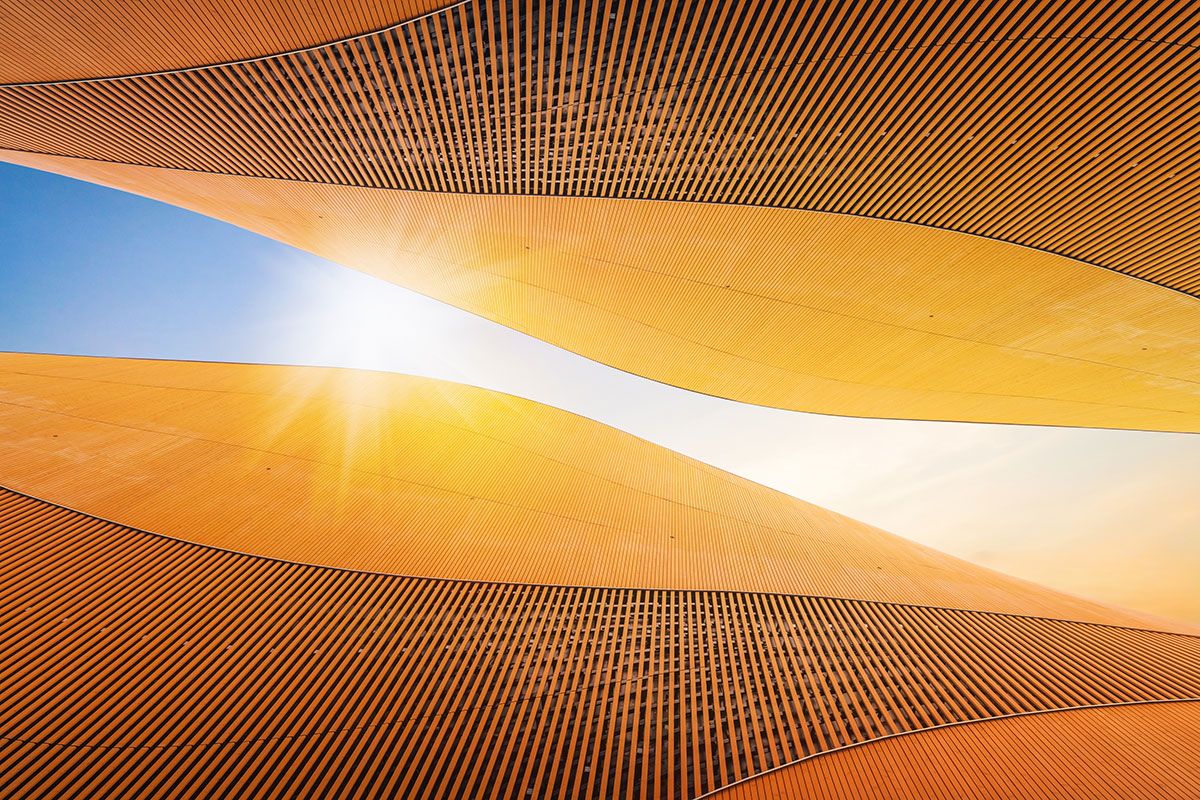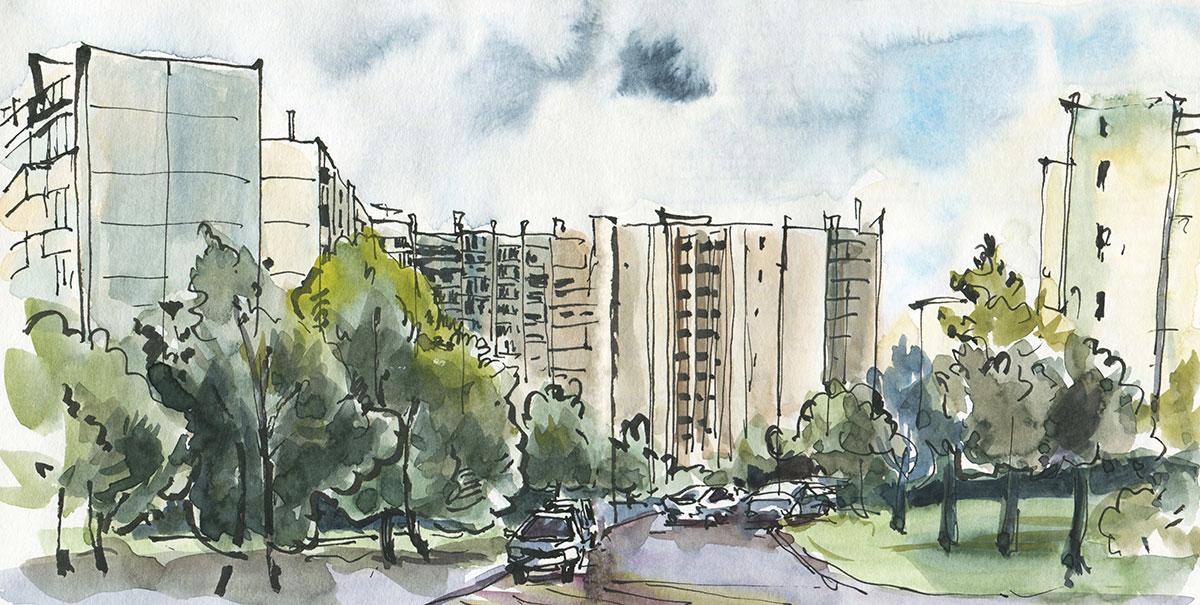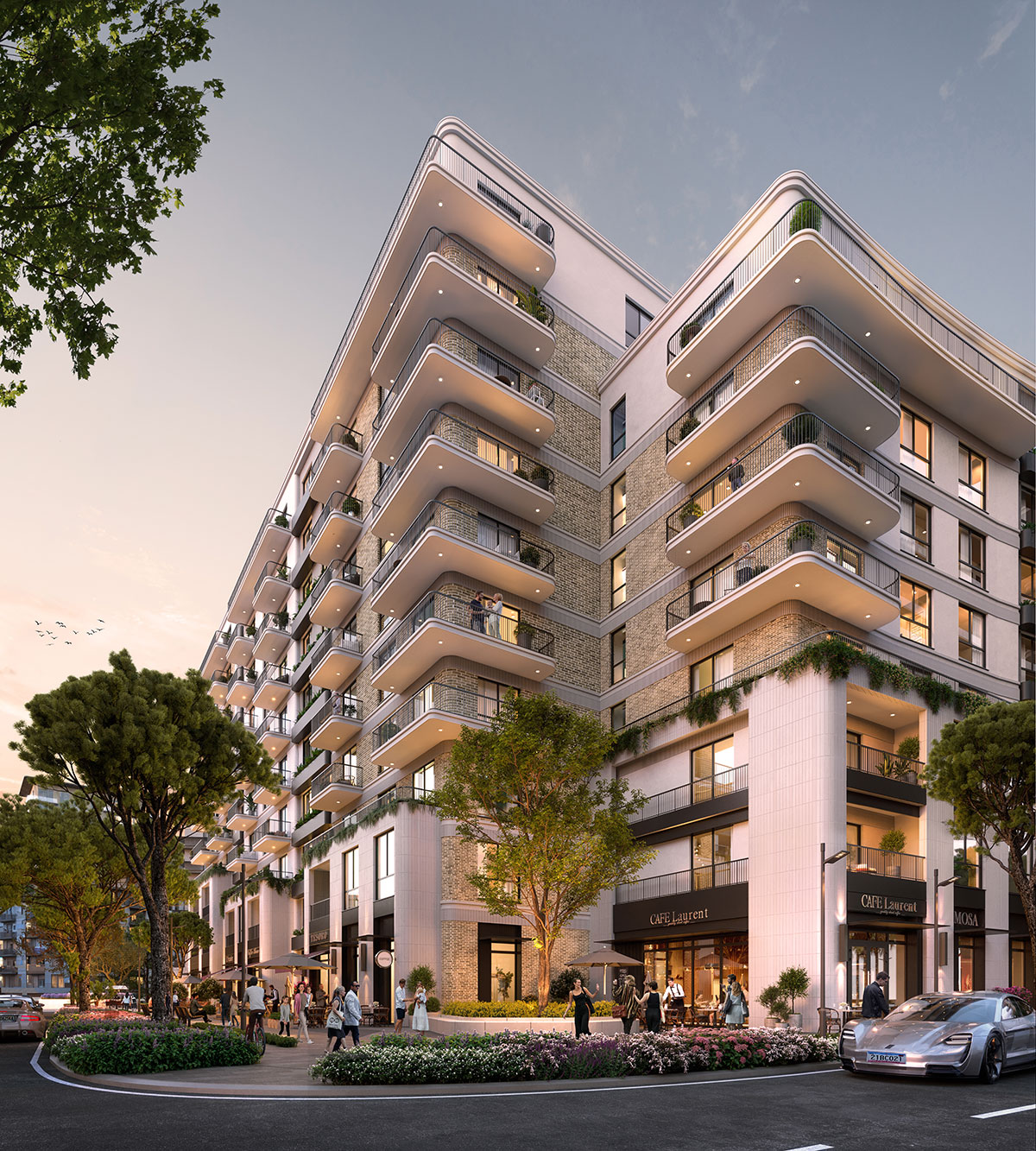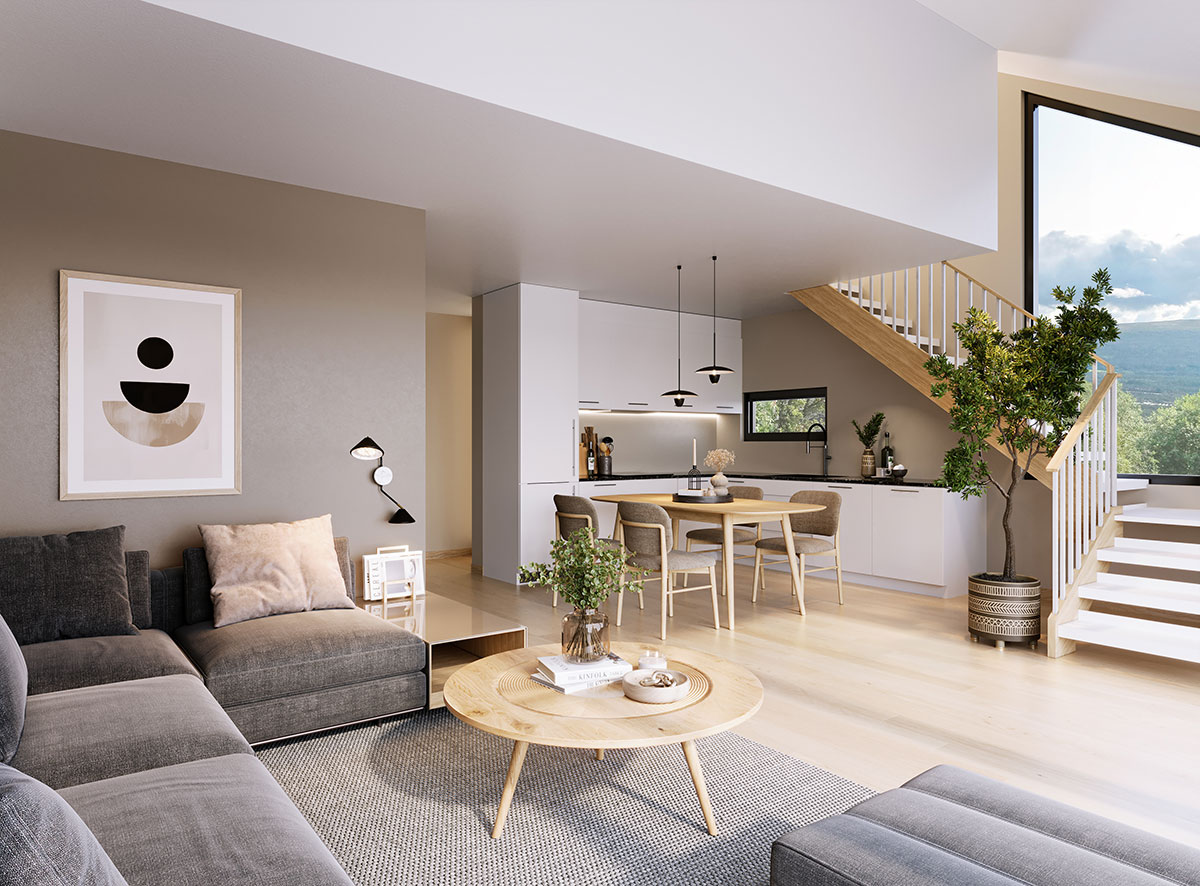Architectural Vision: The Artistry of Rendering Style

Arqsix
May 27th, 2024

In the world of architecture and design, the ability to convey ideas and concepts visually is paramount. It’s the bridge between imagination and realization, where sketches and blueprints transform into tangible visions of the future. Architectural rendering software, like V-Ray from Chaos Group, has revolutionized this process by transforming sketches and blueprints into tangible visions, presenting visualizations of the design to all project stakeholders. This is where architectural renderings come into play, serving as powerful tools that breathe life into ideas and concepts.
Over the years, the art of architectural rendering has evolved significantly, from simple sketches to intricate, hyper-realistic images that seem to leap off the page. Today, architects and interior designers have a plethora of rendering styles at their disposal, each offering its own unique way to convey design intent and captivate audiences. The variety of architectural rendering style, including hand-drawn sketchy style, cutaway renderings, and film noir renderings, highlights the diverse visual techniques and approaches used in architectural renderings.
What are Architectural Rendering Techniques?
Architectural rendering techniques encompass a wide range of methods used to create visual representations of architectural designs. These techniques vary in approach and style, each offering its own unique way of conveying the essence of a design.
At its core, rendering involves the process of generating images or animations that depict architectural spaces. It's a crucial tool in the design process, allowing architects, designers, and clients to visualize and communicate ideas effectively.
One common approach to rendering is to strive for realism, where the goal is to create images that closely resemble photographs. This technique often involves using advanced software and rendering engines to simulate real-world lighting, materials, and textures, resulting in highly detailed and accurate visualizations.
Alternatively, some rendering techniques focus on artistic interpretation rather than strict realism. These approaches aim to convey mood, emotion, and design intent through creative means such as painting, drawing, or digital manipulation. They allow for more subjective and expressive visualizations that capture the essence of a design in a unique way.
Beyond these approaches, there are countless other rendering techniques that cater to different design preferences and project requirements. Whether it's exploring abstract concepts, simplifying forms to their essential components, or infusing a sense of whimsy and playfulness, each technique offers its own way of engaging viewers and communicating design ideas effectively. Ultimately, the choice of rendering technique depends on the goals of the project, the preferences of the designer, and the intended audience.
3D Rendering Styles and Visualization Techniques You Should Know
There are several styles when it comes to rendering style and you should be aware of the most popular ones, as they usually define architectural projects. Among these, hyper realistic renderings stand out for their ability to achieve high levels of detail and realism, capturing the intricate details of architectural designs with a visually accurate and detailed approach. Rendered images will always have a very distinct style, which can affect the overall design, it can affect the intricate details and other different elements. Different rendering styles, including interior design, play a crucial role in visualizing and communicating the design of interior spaces, showcasing the entire interior space through 3D rendering with emphasis on details, materials, and lighting.
Photorealistic Rendering
Photorealistic rendering is a pinnacle achievement in the world of architectural visualization, where designs are brought to life with astonishing detail and accuracy. This rendering style aims to create images that are indistinguishable from photographs, immersing viewers in a hyper-realistic representation of architectural spaces. By meticulously simulating light, texture, and materials, photorealistic rendering evokes a sense of authenticity that allows clients and designers to visualize the finished project with unparalleled clarity.
The magic of photorealistic rendering lies in its ability to capture the essence of a design, from the intricate details of building elements to the play of light and shadow. With advanced rendering software and techniques, architects and interior designers can showcase their vision with stunning accuracy, enabling clients to experience the space before it's even built. Whether it's a sleek modern apartment or a sprawling urban landscape, photorealistic rendering transforms architectural concepts into compelling visual narratives that inspire and engage.
 Created by Arqsix
Created by Arqsix
Stylized Illustration
Stylized illustration brings a unique artistic flair to architectural renderings, offering a departure from strict realism to embrace creativity and expression. This rendering style takes inspiration from various art forms, such as painting and drawing, to create visually captivating images that go beyond mere representation. By infusing architectural scenes with artistic elements, stylized illustration adds depth and character, elevating the visual storytelling aspect of design projects.
From bold brushstrokes to vibrant color palettes, stylized illustration transforms architectural concepts into works of art. It allows designers to convey mood, emotion, and narrative through visual cues, creating an immersive experience for viewers. By emphasizing certain aspects of a design while simplifying others, stylized illustration can communicate the essence of a project in a way that resonates with clients and stakeholders. Whether it's evoking a sense of nostalgia with a vintage-inspired illustration or capturing the energy of a bustling cityscape with dynamic linework, this rendering style offers endless possibilities for creative expression in architectural visualization.
Minimalist Rendering
Minimalist rendering embodies the principle of "less is more," stripping away unnecessary details to focus on the essential elements of a design. This rendering style embraces clean lines, uncluttered spaces, and a limited color palette to convey architectural concepts with simplicity and elegance. By eliminating distractions and noise, minimalist rendering allows viewers to appreciate the purity of form and the beauty of negative space, resulting in visually impactful images that evoke a sense of calm and clarity.
In minimalist rendering, every element serves a purpose, from the basic geometric shapes that define architectural structures to the subtle interplay of light and shadow. By emphasizing form over embellishment, this style highlights the inherent beauty of design without unnecessary embellishments. Whether it's a sleek modern residence or a minimalist office space, minimalist rendering captures the essence of minimalism, conveying a sense of sophistication and refinement. This approach not only enhances the visual appeal of architectural renderings but also communicates the designer's intent with precision and clarity.
Abstract Rendering
Abstract rendering takes architectural visualization to new heights by breaking away from traditional representation and exploring the realm of imagination. This rendering style embraces experimentation and creativity, using non-representational forms, colors, and textures to evoke emotion and provoke thought. By distorting reality and playing with perception, abstract rendering offers a fresh perspective on architectural design, pushing the boundaries of what is possible.
In abstract rendering, buildings and spaces are transformed into dynamic compositions of shapes and colors, where architectural elements become symbols rather than literal representations. This allows designers to convey the mood, atmosphere, and conceptual ideas behind a project in a more subjective and interpretive way. Whether it's through the use of bold geometric patterns, surreal landscapes, or unexpected juxtapositions, abstract rendering invites viewers to engage with the design on a deeper level, sparking their imagination and challenging their preconceptions.
By embracing abstraction, architects and designers can explore new possibilities and inspire more innovative approaches to design. Abstract rendering encourages experimentation and encourages a more open-minded approach to architectural visualization, where the focus is not only on depicting reality but also on creating an emotional and intellectual connection with the audience. Whether used as a conceptual tool or as a way to communicate complex ideas, abstract rendering offers a fresh and exciting way to experience architecture.
 Image by syolacan, iStock
Image by syolacan, iStock
Sketchy Rendering
Sketchy rendering brings a touch of authenticity and charm to architectural visualization by mimicking the spontaneous and imperfect nature of hand-drawn sketches. This rendering style celebrates the creative process, with loose lines and rough textures capturing the essence of the design in its early stages. By embracing imperfection and spontaneity, sketchy rendering adds a sense of warmth and personality to architectural renderings, inviting viewers to connect with the design on a more intimate level.
In sketchy rendering, the focus is not on precision or realism, but rather on capturing the essence of the design through expressive strokes and gestural marks. This allows designers to convey the energy and dynamism of their ideas in a way that feels authentic and spontaneous. Whether it's a quick thumbnail sketch or a more detailed illustration, sketchy rendering conveys a sense of immediacy and creativity that resonates with viewers.
Cartoonish Rendering
Cartoonish rendering injects a sense of whimsy and playfulness into architectural visualization, transforming buildings and spaces into vibrant, animated worlds. This rendering style draws inspiration from the colorful and exaggerated aesthetics of cartoons, using bold lines, bright colors, and exaggerated proportions to create visually engaging images. By embracing a more lighthearted and imaginative approach, cartoonish rendering brings a sense of joy and wonder to architectural renderings, appealing to both clients and designers alike.
From whimsical cityscapes to charming residential neighborhoods, cartoonish rendering offers endless opportunities for storytelling and creative exploration. It allows designers to convey complex ideas and concepts in a fun and accessible way, making architecture more relatable and engaging to a wider audience. Whether used for marketing materials, presentations, or simply as a way to explore design ideas, cartoonish rendering brings a sense of fun and excitement to the world of architecture.
This kind of visual representation is perhaps the farthest from the photorealistic rendering style.
Wireframe Rendering
Wireframe rendering offers a unique perspective on architectural visualization by focusing on the underlying structure and form of a design. This rendering style presents buildings and spaces as skeletal frameworks, with lines and vertices defining their shape and layout. By stripping away surface details and textures, wireframe rendering highlights the fundamental elements of architecture, allowing viewers to see the structure in its purest form.
In wireframe rendering, architectural elements are represented as simple geometric shapes, such as lines, points, and polygons. This minimalist approach allows designers to emphasize the spatial relationships between different elements and highlight the overall composition of the design. By focusing on the skeleton of the building, wireframe rendering provides insights into its structural integrity, circulation patterns, and spatial organization. This kind of rendering is also helpful when it comes to architectural drawings.
Beyond its practical applications, wireframe rendering also has aesthetic appeal, with its clean lines and abstract forms creating visually striking images. Whether used to convey design concepts to clients or to explore spatial relationships during the design process, wireframe rendering offers a versatile and insightful tool for architects and designers. It provides a clear and concise representation of architectural form, allowing viewers to appreciate the beauty of structure and the elegance of design.
Watercolor Rendering
Watercolor rendering brings a touch of painterly elegance to architectural visualization and 3D rendering, infusing designs with warmth, texture, and emotion. This rendering style takes inspiration from traditional watercolor painting techniques, using translucent washes of color and fluid brushstrokes to create soft, dreamy images that evoke a sense of nostalgia and charm. By embracing the organic and unpredictable nature of watercolor, this rendering style adds a human touch to digital renderings, inviting viewers to connect with the design on an emotional level.
In watercolor rendering, buildings and landscapes are depicted with loose, expressive brushwork, capturing the fluidity and movement of watercolor pigments. Architectural elements blend seamlessly with natural surroundings, creating a sense of harmony and balance in the composition. This approach allows designers to convey the atmosphere and mood of a space, whether it's the tranquil serenity of a garden retreat or the vibrant energy of a bustling urban scene.
This rendering style is often used for interior rendering and sometimes exterior elements when nature ascpects are in the focus.
 Image by MarinaZakharova, iStock
Image by MarinaZakharova, iStock
The Significance of Different Rendering Styles
Understanding the significance of different rendering styles is essential for architects, designers, and clients alike. Each rendering style offers its own unique benefits and can play a crucial role in communicating the conceptual design and engaging stakeholders.
One significant aspect of rendering styles is their ability to evoke emotion and atmosphere. For example, photorealistic rendering can create a sense of realism that helps clients visualize the final project with accuracy and confidence. On the other hand, stylized rendering techniques can add artistic flair and convey mood in a more subjective way, allowing for a more creative interpretation of the design.
Additionally, rendering styles can influence the perception of a project's aesthetics and design intent. Minimalist rendering, with its emphasis on clean lines and simplicity, can convey a sense of modernity and sophistication. Abstract rendering techniques, on the other hand, can push the boundaries of imagination and encourage viewers to think outside the box.
Moreover, rendering styles can also impact the overall communication and understanding of a project. Cartoonish rendering, for instance, can make complex ideas more accessible and engaging by simplifying architectural elements and adding a touch of whimsy. Similarly, wireframe rendering can provide valuable insights into the structural integrity and spatial relationships of a design in a clear and concise manner. A range of rendering techniques can offer a range of diverse narratives, meaning that your potential clients will be able to see the important elements, specifically the ones you want to show them.
 Created by Arqsix
Created by Arqsix
Crafting Atmosphere: The Role of Rendering Styles in Setting the Mood
Understanding how different rendering techniques influence the atmosphere of a design is essential for architects, designers, and clients alike as it helps to ensure that the visual representation aligns with the intended perception and emotional response.
Evoke Emotion through Aesthetics
Rendering styles have the power to evoke a wide range of emotions through their aesthetic choices. Photorealistic rendering, with its attention to detail and realism, can create a sense of comfort and familiarity, making viewers feel as though they are already inhabiting the space. On the other hand, abstract rendering techniques, with their bold colors and unconventional forms, can evoke feelings of curiosity, intrigue, or even awe. By understanding how different rendering styles influence emotional responses, architects and designers can tailor their visualizations to elicit specific reactions from viewers.
Play of Light and Shadow: Enhancing Ambiance
Lighting plays a crucial role in shaping the atmosphere of architectural renderings. Whether it's the soft glow of a sunset casting long shadows across a room or the harsh contrast of sunlight streaming through a window, the play of light and shadow can dramatically affect the perceived ambiance of a space. Rendering techniques that effectively utilize lighting can enhance the mood of a design, creating feelings of warmth, serenity, drama, or mystery. By manipulating light and shadow in their visualizations, architects and designers can evoke specific emotions and convey the intended atmosphere of their projects.
Tailoring Styles to Suit Project Goals
Choosing the right rendering style is essential for effectively communicating the design intent and narrative of a project. Different styles have different strengths and can be used to convey specific atmospheres depending on the project goals. For example, a minimalist rendering style may be ideal for showcasing the clean lines and simplicity of a modern design, while a stylized or cartoonish approach may be better suited for projects aimed at evoking a sense of playfulness or whimsy. By aligning rendering styles and different settings with project goals, architects and designers can ensure that their visualizations effectively convey the desired atmosphere and resonate with their intended audience.
 Created by Arqsix
Created by Arqsix
Balancing Realism and Creativity: Navigating Different Rendering Styles
Striking the right balance between realism and creativity is essential for creating compelling and effective renderings. While realism allows viewers to accurately understand the physical aspects of a design, creativity adds depth, emotion, and narrative to the visualization. Navigating the spectrum of rendering styles involves understanding how to blend these elements harmoniously to convey the intended message and engage the audience effectively.
Striking the Right Balance
Balancing realism and creativity in architectural rendering is a delicate dance that requires careful consideration of various factors. Realism provides the foundation for accurately representing architectural elements, ensuring that viewers can understand the physical aspects of the design. However, creativity adds depth and emotion to the rendering, allowing designers to convey atmosphere, mood, and narrative. Striking the right balance between these two elements is crucial to creating visually compelling and effective renderings that resonate with the audience.
Architects and designers must consider the purpose and audience of their renderings when finding this balance. For client presentations or marketing materials, a high level of realism may be necessary to accurately convey design details and instill confidence in the project. However, incorporating creative elements such as lighting, composition, and storytelling can elevate the rendering and create a more engaging experience for the viewer. By understanding the needs and expectations of the audience, designers can tailor their approach to strike the right balance between realism and creativity.
Furthermore, technology plays a significant role in achieving this balance. Advancements in rendering software and hardware have made it easier than ever to create highly realistic images. However, this level of realism can sometimes come at the expense of creativity and artistic expression. By leveraging the capabilities of modern rendering tools while also exploring creative techniques and styles, architects and designers can achieve a harmonious blend of realism and creativity that effectively communicates their vision and captivates the audience.
Creative Expression in Realistic Renderings
While photorealistic rendering aims to accurately depict architectural designs, there is still ample room for creative expression within this style. Realism does not have to mean sacrificing creativity; instead, it can serve as a canvas for artistic exploration. Designers can add creative touches through composition, lighting, and material choices, allowing them to convey mood, emotion, and narrative within a realistic framework.
One way to inject creativity into realistic renderings is through the use of lighting. Manipulating light and shadow can dramatically alter the mood and atmosphere of a scene, transforming a mundane space into a captivating environment. By experimenting with different lighting techniques, such as dramatic spotlights or soft natural light, designers can evoke specific emotions and create a sense of drama or tranquility in their renderings.
Another avenue for creative expression in realistic renderings is through storytelling. While realism focuses on accurately depicting the physical aspects of a design, adding narrative elements can enrich the viewer's experience and create a more immersive visualization. Incorporating human figures, furniture, and other contextual details can help bring the space to life and provide viewers with a sense of scale, purpose, and context.
Pushing Boundaries: Leveraging Abstract and Experimental Rendering Styles
While realism is often the default approach in architectural rendering, there is a growing interest in pushing the boundaries and exploring more abstract and experimental rendering styles. Abstract rendering techniques allow designers to break free from the constraints of reality and explore new ways of visualizing architectural concepts. By simplifying forms, exaggerating proportions, and playing with color and texture, designers can create visually striking images that challenge perceptions and spark creativity.
One benefit of abstract rendering styles is their ability to convey complex ideas and emotions in a more intuitive and visceral way. By stripping away unnecessary details and focusing on the essence of the design, abstract renderings can evoke a strong emotional response from viewers, making them ideal for projects where storytelling and mood-setting are paramount.
Also, abstract rendering styles offer designers the freedom to experiment and explore new ideas without being limited by the constraints of physical reality. This can lead to innovative design solutions and unexpected discoveries that may not have been possible with more traditional rendering techniques. By embracing abstraction and pushing the boundaries of what is possible in architectural visualization, designers can create renderings that inspire, provoke thought, and ignite imagination.
FAQs
Our location
Ready to share your expertise?
We welcome submissions from talented writers and experts in various fields who are passionate about sharing their knowledge and insights with our audience.
Write for UsArqsix - Shaping Stories, Shaping Spaces
Elevating real estate marketing for a world that’s always evolving.
2025 © Arqsix. All Rights reserved. |Sitemap|Privacy Notice